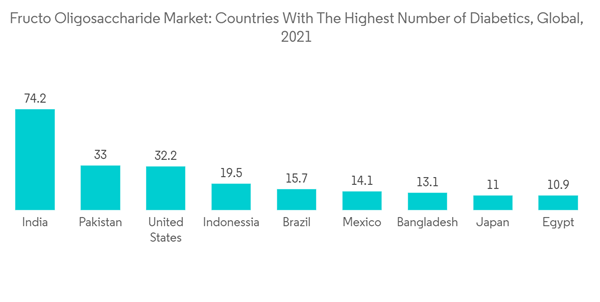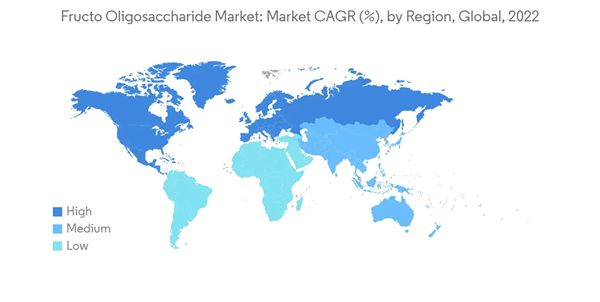The Fructo Oligosaccharide Market size is estimated at USD 3.85 billion in 2024, and is expected to reach USD 6.25 billion by 2029, growing at a CAGR of 10.19% during the forecast period (2024-2029).
Fructooligosaccharide is a slightly sweet carbohydrate found naturally in the roots of certain plants (chicory root, Jerusalem artichoke, leek, asparagus, wheat bran, and bananas) or is synthesized by the enzymatic extraction from inulin. The increased application in industries like animal feed and pharmaceuticals is expected to propel the market's growth. The increasing use of products and dietary supplements with functional benefits, increasing health-conscious among the global population, and increasing concerns about obesity are driving the market for prebiotics, such as FOS, GOS, and MOS. The growing demand for prebiotics and dietary supplements is also supporting the demand for fructooligosaccharides.
With increasing knowledge of the product among consumers and a better understanding of its functions, the demand for fructooligosaccharides (FOS) is expected to increase rapidly over the forecast period. Moreover, changing lifestyles and rising concerns regarding health are expected to augment the market's growth. Increased prebiotic demand and rising government support are expected to augment the market's growth over the forecast period. Rising concerns regarding gut health and increased demand for low-calorie sweeteners are expected to fuel product growth over the next five years.
The actions performed by the industry participants are assisting the market's expansion. The emphasis on R&D efforts is one of the initiatives positively impacting the market. This would encourage the overall expansion of the industry and the recognition of the beneficial effects of FOS on health. The development of novel production methods that use recombinant enzymes, effective purification systems, enzyme engineering, and new substrates has also contributed to a decrease in the manufacturing cost and FOC's overall pricing, thus fuelling the market's growth.
The market for fructooligosaccharides is being driven by rising demand for low-calorie sweeteners. It is used as a sweetener as it is 40% sweeter than sucrose but only has a third of the calories. It can replace sucrose as a low-calorie sweetener. Due to its low glycemic index, it is suitable for people with diabetes and adds fiber to the diet. Consumers worldwide have been safely using and enjoying low-calorie sweeteners for many years. The market for fructooligosaccharides is predicted to rise as the demand for low-calorie sweeteners expands. Various physical and psychological advantages of low-calorie foods include weight loss, diabetes management, and reduced risks of obesity, which are expected to propel the market's growth.
FOS are commonly used as food additives and ingredients in dietary supplements across the region. They are also used in the pharmaceutical industry. Germany's leading position in the European FOS market is due to the strong demand from these industries. The German government has put in place strict regulations on the production of FOS. These regulations have helped ensure that only high-quality products are produced in the country, further boosting the position of German-made FOS products globally.
This product will be delivered within 2 business days.
Fructooligosaccharide is a slightly sweet carbohydrate found naturally in the roots of certain plants (chicory root, Jerusalem artichoke, leek, asparagus, wheat bran, and bananas) or is synthesized by the enzymatic extraction from inulin. The increased application in industries like animal feed and pharmaceuticals is expected to propel the market's growth. The increasing use of products and dietary supplements with functional benefits, increasing health-conscious among the global population, and increasing concerns about obesity are driving the market for prebiotics, such as FOS, GOS, and MOS. The growing demand for prebiotics and dietary supplements is also supporting the demand for fructooligosaccharides.
With increasing knowledge of the product among consumers and a better understanding of its functions, the demand for fructooligosaccharides (FOS) is expected to increase rapidly over the forecast period. Moreover, changing lifestyles and rising concerns regarding health are expected to augment the market's growth. Increased prebiotic demand and rising government support are expected to augment the market's growth over the forecast period. Rising concerns regarding gut health and increased demand for low-calorie sweeteners are expected to fuel product growth over the next five years.
The actions performed by the industry participants are assisting the market's expansion. The emphasis on R&D efforts is one of the initiatives positively impacting the market. This would encourage the overall expansion of the industry and the recognition of the beneficial effects of FOS on health. The development of novel production methods that use recombinant enzymes, effective purification systems, enzyme engineering, and new substrates has also contributed to a decrease in the manufacturing cost and FOC's overall pricing, thus fuelling the market's growth.
Fructo-Oligosaccharides Market Trends
Rising Demand for Low-calorie Foods
Due to the ongoing change in consuming habits and preference for nutritious food items, consumers are seeking fast, cheap, and luxuriant food options that satisfy their daily nutritional requirements. The use of raw materials, processing, improvements in preservation and innovative packaging methods are contributing to the food industry's rapid evolution. Growth opportunities in this market would be provided by rising consumer knowledge of healthy foods and the healthy food market. Consumers are increasingly reducing their sugar intake as part of a dietary change that promotes overall wellness and health. Sugar reduction has risen to the top of the health priority list, especially for customers trying to control their weight.The market for fructooligosaccharides is being driven by rising demand for low-calorie sweeteners. It is used as a sweetener as it is 40% sweeter than sucrose but only has a third of the calories. It can replace sucrose as a low-calorie sweetener. Due to its low glycemic index, it is suitable for people with diabetes and adds fiber to the diet. Consumers worldwide have been safely using and enjoying low-calorie sweeteners for many years. The market for fructooligosaccharides is predicted to rise as the demand for low-calorie sweeteners expands. Various physical and psychological advantages of low-calorie foods include weight loss, diabetes management, and reduced risks of obesity, which are expected to propel the market's growth.
Europe Holds a Significant Market Share
Europe holds the largest share in the fructooligosaccharide market due to the rising demand for baby food and the presence of numerous infant formula manufacturers in the region. Due to growing health awareness and rising disposable income, increasing urbanization is fueling the sales of packaged food items, augmenting the demand for fructooligosaccharide as a sweetener in the market. The European Food Safety Authority (EFSA) recently issued a positive opinion for a health claim about replacing sugars with non-digestible carbohydrates in foods and beverages and reducing post-prandial glycaemic responses. The EFSA experts mentioned that replacing sugars with any non-digestible carbohydrates would result in the claimed effect. For the health claim to be valid, food and drinks should contain at least 30% fewer sugars, as compared to the reference containing sugars.FOS are commonly used as food additives and ingredients in dietary supplements across the region. They are also used in the pharmaceutical industry. Germany's leading position in the European FOS market is due to the strong demand from these industries. The German government has put in place strict regulations on the production of FOS. These regulations have helped ensure that only high-quality products are produced in the country, further boosting the position of German-made FOS products globally.
Fructo-Oligosaccharides Industry Overview
The fructooligosaccharide market is highly competitive in nature due to the presence of global players. Some of the key players in the fructooligosaccharide market include Südzucker AG (BENEO), Cargill Inc., Ingredion Incorporated, Tereos Group, and Baolingbao Biological Co. Ltd. Companies are strategically increasing their production capabilities and focusing on investments and R&D for new product launches.Additional Benefits:
- The market estimate (ME) sheet in Excel format
- 3 months of analyst support
This product will be delivered within 2 business days.
Table of Contents
1 INTRODUCTION
4 MARKET DYNAMICS
5 MARKET SEGMENTATION
6 COMPETITIVE LANDSCAPE
Companies Mentioned (Partial List)
A selection of companies mentioned in this report includes, but is not limited to:
- Südzucker AG (BENEO)
- Cargill Inc.
- Ingredion Incorporated
- Tereos Group
- Royal Friesland Campina NV
- Meiji Holdings Co. Ltd
- Galam Group
- Brenntag SE
- Jarrow Formulas Inc.
- Tate & Lyle PLC
- Baolingbao Biological Co. Ltd
Methodology

LOADING...










